Great Britain, Ireland and the rest of the British Isles lie just northwest of the European mainland. Together they form one of the most visited regions on the planet, containing some of the world's most recognisable landmarks, historical sites dating back thousands of years, and unique natural environments, world cities, quaint towns, and remote and isolated areas and islands.
Countries
edit| United Kingdom (England, Scotland, Wales, Northern Ireland) From the rolling hills of England, to the deep valleys of Wales, the beautiful glens of Scotland to the dramatic coastline of Northern Ireland, the former heart of the world's largest empire remains just as magnificent as it was when it ruled the waves. |
| Ireland Often called the 'Emerald Isle', the Republic of Ireland boasts an expansive and fascinating history, with a landscape that never ceases to astound. |
Dependencies
edit| Isle of Man A British Crown Dependency in the Irish Sea, directly between the islands of Great Britain and Ireland. |
| Channel Islands (Guernsey, Jersey) A group of islands making up two British Crown Dependencies in the English Channel, located off the coast of Normandy, France. It has many linguistic similarities with Normandy. |
Cities
edit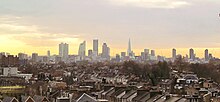
- 1 Belfast — The capital of Northern Ireland and a cultural meeting point between the United Kingdom and Ireland.
- 2 Birmingham — Located in the centre of England, Birmingham is the economic powerhouse of the Midlands. It is the second largest city in this region.
- 3 Cardiff — The capital of Wales, Cardiff is a lively and exciting capital city.
- 4 Dublin — Home of Guinness and Western Roman Catholicism, Ireland's capital is more than just a pretty face.
- 5 Edinburgh — Sometimes referred to as 'the Athens of the North', Edinburgh is Scotland's capital.
- 6 Glasgow — The biggest city in Scotland, 40 miles west from Edinburgh and gateway to the western glens and lochs.
- 7 Liverpool — Home of the Scouse, The Beatles and the Three Graces
- 8 London — A truly iconic, global city, the capital and largest city of both England and the United Kingdom, it buzzes with different cultures and a more than two-thousand year history to match.
- 9 Manchester — Birthplace of the Industrial Revolution and Birmingham's rival for the title of 'second city', Manchester is a lively, thriving destination.
Other destinations
edit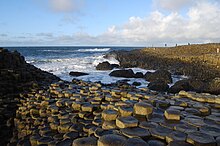
- 1 Aran Islands
- 2 Cliffs of Moher
- 3 Giant's Causeway — 40,000 basalt rocks rise spectacularly out of the sea at Northern Ireland's only UNESCO site
- 4 Isle of Arran — "Scotland in miniature" packs in mountain, sea, beach and forest and a geologically diverse terrain
- 5 Lake District National Park
- 6 Loch Ness — Scotland's most heroic of lochs, this northerly one is said to be home of the ferocious Loch Ness Monster.
- 7 Pembrokeshire — Great Britain's only coastal national park
- 8 Snowdonia National Park — mountainous region in northwestern Wales, including and named after Snowdon, the highest mountain in Wales.
- 9 Stonehenge — Located on Salisbury Plain in southern England, Stonehenge is a place of pilgrimage on the Winter and Summer Solstices.
Understand
edit| Britain and Ireland historical travel topics: Celts → Medieval → Early modern → Industrial Britain → British Empire |
The British Isles also include many smaller islands, one of which is the British Crown dependency of the Isle of Man. The Channel Islands are also Crown dependencies so they are included here even though they are not geographically part of the archipelago; they lie just off the French coast.
Trains, ferries, planes and roads connect the region together. English speaking visitors are guaranteed to be able to communicate everywhere within the region, read any important signs and maps, and get to know the people.
The UK once ruled the huge British Empire, and since independence was gained by most of the territories of it, the Commonwealth of Nations continues to be an important political association, now of 54 member states.
Talk
edit
English is spoken everywhere, by almost everyone of school age and over. In the Republic of Ireland, Irish and English are the official languages; regions where Irish is the dominant language are called Gaeltachtaí. In addition to English and Irish (spoken by some in Northern Ireland), the UK's other indigenous languages include Scottish Gaelic in the Highlands and Hebrides, Scots in Lowland Scotland and Northern Ireland, and Welsh in Wales. Cornish nearly became extinct, but has been revived by some enthusiasts in Cornwall. Manx on the Isle of Man is another vulnerable language. In the Channel Islands, French has co-official status with English, though non-Anglophone islanders are more likely to speak one of three Norman dialects, Jerriais, Guernesiais and Sercquiais.
Visitors with reasonable fluency in English should have no difficulty anywhere in the region. There are however strong regional differences in the way English is spoken, and it is not uncommon for a native speaker from one region to have some difficulty in understanding another from a different region - for example a Donegal native in Yorkshire, or a Londoner in Glasgow. This actually makes it easier for a non-native speaker to get by, as most people are used to decoding English spoken in many different ways. Do not be embarrassed if you cannot understand someone, or they cannot understand you, as even native speakers have this problem from time to time! The article English language varieties covers some of the dialect differences.
All official signs in the UK, Channel Islands and Isle of Man use English, but in many areas signs are bilingual, and occasionally trilingual, using English and the additional local language(s). In the Republic of Ireland signs are bilingual English and Irish, apart from in the Gaeltachtaí where the signs are in Irish only. Foreign languages are almost entirely absent from official signage.
The UK has attracted a good deal of immigration creating sizeable communities from all over the world, and it is common to hear other languages in the cities.
Get in
edit
Visitors may find more useful information in the "Get in" sections of the specific part of the region they wish to enter.
Immigration and visa requirements
editThere are five separate jurisdictions with their own immigration rules in this region: UK, Ireland, Isle of Man, and the two bailiwicks of the Channel Islands. They still comprise a Common Travel Area with considerable co-operation and co-ordination among the various authorities, which helps the vast majority of travellers enjoy hassle-free travel when crossing borders.
A UK visa is usually also valid for the Isle of Man and the Channel Islands, but Ireland maintains a separate visa system. Travellers may wish to check the requirements for the specific jurisdictions.
The region does not belong to the Schengen area, but EU and EEA citizens do not need visas for short time stays as tourists. Working permits are needed on the Channel Islands and on the Isle of Man.
By plane
edit- See also: Flying in Europe
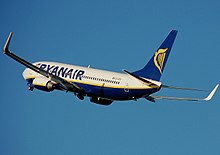
There are external direct flights to every constituent part of this region except to the Isle of Man.
The largest port of entry to this region is London Heathrow Airport. Situated 15 miles west of Central London, Heathrow offers a large choice of international destinations, with direct flights from most countries in the world. Many onward air connections within the region are possible. Coach connections to other places in mainland Great Britain are generally good. Rail connections from Heathrow to London are good; however, there being no direct services to other parts of Great Britain, a change of train will be necessary in London or possibly at Reading Station, which is served by a regular shuttle coach.
Heathrow's location in the far South East of the region means that many travellers to other parts of these islands may be better off getting a direct flight to the specific area in which they are interested. However, from some parts of the world Heathrow is the only realistic option to get into the region, and further arrangements for onward travel would then be required.
Other airports such as Birmingham, Dublin, Edinburgh, Glasgow, London Gatwick, Manchester, Newcastle and Shannon have both long-haul flights and flights to European cities.
Air France and KLM operate feeder flights to many airports in the region from their respective intercontinental hubs in Paris Charles de Gaulle and Amsterdam Schiphol.
By train
editBy boat
editThe traditional way of getting to the British Isles. See Ferries to the British mainland for more information.
Get around
editThe Common Travel Area
edit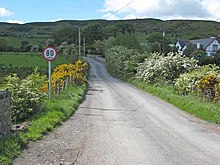
The United Kingdom, Ireland, the Isle of Man, and the Channel Islands maintain a common travel area, somewhat akin to the Schengen Area on continental Europe. Broadly speaking, crossing the borders is very simple compared with most other international borders.
Ireland and the United Kingdom have been separate countries for more than a century, but for the most part both have found it beneficial to maintain relatively open borders. However, because of the way it has developed over the years, the Common Travel Area arrangement is not as formalised as other similar arrangements (such as the Schengen Area), and so the exact rules can be quite complex for some third country nationals.
- Nationals of a "Common Travel Area" country can travel to any of the others without a passport but can be asked to provide identity documents.
- Citizens of the European Economic Area have the right to travel between the two countries and they require a national ID card or a passport.
- Visitors from other countries that do not require a visa and have been checked through immigration in one part of the area (e.g. England) would not normally have to go through immigration procedures when continuing a journey to another part of the area (e.g. Ireland) but must carry a valid passport.
- Visitors from a country needing a visa to enter one Common Travel Area country may need to apply for a visa to enter the other. Whilst all five jurisdictions have very similar visa rules, it is important to remember that unlike the Schengen Area, the United Kingdom and Ireland maintain separate visa systems. Having a visa for the UK entitles you to enter the Isle of Man and Channel Islands (and vice versa), but the same visa does not entitle you to enter Ireland (or vice versa).
In general, if you have a passport or EU national identification card, you can avoid any hassles by carrying it, and using it for identification. Also check the identification requirements of any airline or ferry you may be taking.
By plane
editThere have historically been extensive internal air routes among the islands, though the collapse of the largest regional airline in early 2020 and the COVID-19 pandemic shutting down most flights means it is hard to say which routes will remain in the longer term. The main airlines offering inter-island travel are Aer Lingus, Aurigny, British Airways, Eastern Airways, easyJet, and Ryanair. This area is also home to the world's shortest flight; lasting only 53 seconds from Westray, Scotland to Papa Westray, Scotland.
By boat
editGreat Britain and Ireland are linked by a number of ferry routes, with the busiest and quickest crossing being Holyhead to Dublin, operated by Irish Ferries and Stena Line in competition. The Isle of Man's Steam Packet company operates out of Douglas to Belfast, Dublin, and Liverpool. The three main Channel Islands are linked to the south coast of England (Poole and Portsmouth) by Condor Ferries, which also operates inter-island routes. The Scottish islands also have extensive ferry connections with each other and with the British mainland.
By car
edit- Wikivoyage has guides to Driving in Ireland and Driving in the United Kingdom
Unlike continental Europe, all countries and territories in this region drive on the left. The UK, Channel Islands, and Isle of Man all use miles and mph in their road signs, while the Republic of Ireland (ROI) uses kilometres and km/h. Road signs mostly follow European norms, but in the Republic of Ireland, American-style yellow diamond warning signs are used. All road signs are written in English, either as the sole language or alongside a local language, except for in the Gaeltachtaí in rural parts of the ROI, where signs are exclusively in Irish. You can drive your hire car from any Common Travel Area (see above) country to any other, although many hire companies charge an extra fee for doing so.
By train
editGreat Britain and Ireland each have large railway networks, and the train is a popular way to get around in these islands. The Republic of Ireland and Northern Ireland have nationalised systems, with just one company operating services in each and crossborder services jointly operated. Great Britain's National Rail network is run by around 30 different operators; some of these are publicly-owned, but most are private companies. However, scheduling and ticketing are integrated at a national level. Due to privatisation, much of the UK train network has become expensive, and trains can be delayed, therefore it's recommended to plan in advance. The Isle of Man is well-covered by heritage railways, with ticketing integrated with public buses. A short passenger railway also operates in Alderney, with ex-London Underground stock as trains.
Although there is no fixed rail link between Ireland and Great Britain, you can buy a train ticket that will get you from any station in Great Britain to any station on the island of Ireland (and vice versa). The fare you pay includes the ferry crossing, though you will be issued with multiple tickets for different stages of the journey. For example, a journey booked from Cork City to Birmingham New Street will issue one ticket for the train from Cork to Dublin, a different ticket for a specific ferry crossing from Dublin to Holyhead, and a third for the remaining train journey to Birmingham. You can buy this combi ticket from any station ticket office in either country, or through the websites of Iarnród Éireann or National Rail.
See
editUnited Kingdom
edit
Although most visitors will probably visit London at some point, it is well worth getting out of the capital to get a real taste of the country. The UK is a small country with a surprisingly diverse range of attractions, all within a relatively short distance of each other.
After London you could move on to another of the country's vibrant cities which include Edinburgh, Liverpool, Bristol.
For some of the best countryside, head for the National Parks such as the Yorkshire Dales or Dartmoor for a shorter trip, For a longer stay, Scotland has some of the most accessible wilderness in Europe. But it's best to be very well prepared with warm layers and wind proof coat as the weather can change quite quickly without warning.
With the country being an island, there's plenty of coast to visit, and lots of variety too, whether you're after the pretty beaches at places such as the artist's colony at St Ives, seaside resorts such as Blackpool and Bournemouth, or the dramatic mountains and islands of Western Scotland, there is something there for every taste.
There's a wealth of historical sites in the United Kingdom - so many that it would be impossible to list them here. Virtually every city, town and village in the UK has a unique and usually interesting history, from the medieval castles and ancient universities of Durham and Cardiff, to the Roman history of Chester and York, there is something for everyone. There is Skara Brae on the Orkney Islands which are a must see for all of the history boffins
Shoppers looking beyond the capital may want to head to Manchester and Liverpool in the North, Bristol and Exeter in the West or Glasgow and Edinburgh in Scotland.
The United Kingdom was the cradle of the Industrial Revolution in the 18th and 19th centuries. While some industries have closed down, much of Industrial Britain remains to be seen in England, Scotland, Wales, and Northern Ireland. While Ireland had few industries, Irish migrant workers contributed to the industrialisation of the UK.
Ireland
edit
Dublin, the obvious centre, capital and primate city of Ireland, is a must-see and one of a very limited means of entry to Ireland via Dublin Airport and Port.
Shopping centres such as Dundrum, Liffey Valley and Blanchardstown provide locations for shopping, whilst streets such Grafton Street and Henry Street are the places to go.
Croke Park is the largest stadium in Ireland and fourth largest in Europe, with a capacity of 82,300 and is a magnificent tourist destination and a must for anyone interested in sports and a great place to experience national sports such as hurling and Gaelic football. Other sporting centres include the Aviva Stadium and the RDS Arena.
Entertainment is a core source of economy and class in the Dublin region. Dublin, having a vibrant youth life of around 50% of people being under 25, provide young and old with great fun in the pubs of St. Stephens Green, Grafton Street and the obvious Temple Bar region, the heart of entertainment in Ireland and Dublin.
Outside of Dublin, Ireland has all sorts of beautiful sights and medieval ruins, from the Cliffs of Moher on the coast and the Aran Islands to Blarney Castle and the Rock of Cashel.
Do
editThe isles have an astounding heritage of folk, classical, and popular music; see Music in the United Kingdom and Ireland.
Golf
editThe game of golf as we understand it developed here, specifically in Scotland. Despite a strong challenge from Iberia in recent decades, Britain and Ireland remain Europe's most important locations for the sport. Indeed, they can make a strong argument to be the world's main golfing destinations.
Whilst Scotland is considered the home of golf and remains a major worldwide golfing destination in its own right, the Scots' Celtic cousins, in Ireland and more recently Wales, are clearly challenging for pre-eminence as premier golfing destinations, both having well established courses and having invested heavily in new courses too. Indeed, both Ireland and Wales have recently hosted the Ryder Cup. England has the largest number of courses, and so clearly should not be overlooked as a golfing destination either even if its Celtic neighbours hit above their weight.
There are — unsurprisingly — many first-class golf courses in all areas, along with good quality courses to suit more modest pockets.
Buy
editThe pound sterling (£) is the currency of the United Kingdom and its Crown Dependencies, while the euro (€) is the currency of Ireland. With very limited exceptions, neither currency is accepted outside their territories within this region.
United Kingdom and Crown Dependencies
editSterling is the local currency. Euros are accepted in certain border areas; for example, near the land border with Ireland or in certain businesses near ferry terminals and the Channel Tunnel.
Banknotes
edit
In the United Kingdom, the vast majority of banknotes are issued by the Bank of England. Scotland, Northern Ireland and the Crown Dependencies each also have local banknotes. All are in pounds sterling, so are legal currency throughout the UK and Crown Dependencies.
Bank of England notes will always be accepted without problems throughout all the areas that use pounds sterling. The minority notes are also generally easy to spend, though may not always be accepted outside their own region. Any bank will exchange minority banknotes for either Bank of England or the local regional notes (e.g. in Scotland, Scottish notes) free of charge.
Minority pound sterling notes should be changed into Bank of England notes before a traveller leaves the UK or Crown Dependencies as they may be difficult to change in other countries. The exception being that Northern Ireland sterling notes can be easily changed to euros in Ireland.
Large denomination banknotes (£50 and £100) are not always accepted in shops, especially for small purchases. Any bank will change them into smaller denominations.
Coins
editCoins in the United Kingdom are issued centrally by the Royal Mint, and although some designs are specific to England, Northern Ireland, Scotland and Wales, they are legal currency throughout the UK.
The Crown dependencies and overseas territories (e.g. the Falkland Islands and Gibraltar) issue local designs that generally circulate only in their respective territory. These coins conform to the same weight, size, thickness and alloy of the mainland UK coins making them in effect just quirky versions of the regular coins. While not strictly legal tender only the most hidebound retailer will refuse them. Banks will exchange them if need be but this is likely unnecessary given their general acceptance, particularly by vending machines!
Ireland
editOnly the euro is legal tender. Sterling is accepted in certain border locations, for example in ferry ports or near the Northern Ireland land border. Both currencies are usually accepted on board the train (e.g. in the dining car) throughout its journey between Dublin and Belfast. Euro banknotes have no regional variations. Euro coins' reverse sides (tails) are unvarying by region. Their obverse sides (heads) carry a member state's national symbol. This does not affect their validity throughout the Eurozone. Coin spotters may be interested to know that Ireland's relative isolation from the rest of the Eurozone makes it likely to have less diversity among its coins' obverse symbols than almost any other member state.
Eat
edit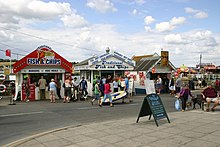
- See also: Cuisine of Britain and Ireland
The stodgy "meat and two veg" on restaurant menus is almost a thing of the past. In the lower price ranges it has largely been replaced by ethnic foods such as Indian, Chinese and Middle Eastern fare. However, the classic fish and chip shops still exist across the region. Predictably, fast food vendors like McDonalds, Burger King and KFC, and a few local chains such as Supermacs and the oddly-named Wimpy have branches almost everywhere.
Convenience food was invented for the Earl of Sandwich in England many years ago and the tradition continues to this day. Cornish pasties and pork pies, whole or by the slice can be found all over England. In Scottish cities hot baked potatoes are sold by street vendors.
Each country has its own national dishes; think haggis with neeps and tatties, colcannon, Welsh rarebit, and roast beef with Yorkshire puddings. Many local areas are famous for their specialities: Devonshire clotted cream, Clonakilty white pudding, Arbroath smokies and Dover sole are familiar examples.
Most pubs have a bar menu of basic food such as a ploughman's lunch: bread and cheese, often served with pickled onions and washed down with a cool glass of best bitter ale. That can certainly hit the spot on a hot summer's day! The "gastropub" is a restaurant and pub rolled into one where the food can vary from mundane to gourmet.
Cuisines available in Great Britain and Ireland today are as varied as the people who have chosen to settle here. Curries first came from India when it was part of the British Empire but are now found everywhere thanks to immigration from East Africa, India, Pakistan and Bangladesh. In cities, cuisines as diverse as Italian, Greek, Persian, Polish, Russian, French, Spanish and Mexican can also be found. And don't be surprised to find decent Szechuan cuisine in a village miles from nowhere.
Drink
editPubs
edit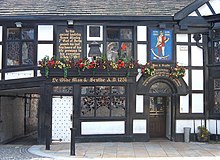
Public houses are premises licensed for the sale of alcoholic drinks for consumption on and off the premises. In pubs, food and drink is ordered at the bar rather than someone coming to your table so you can place your order.
However, some pubs in rougher areas are best avoided. Therefore, you should know which pubs to visit and which pubs not to visit before you go. Generally, pubs in decent areas should be fine; generally, you should watch about more in city centres. Staff at the hotel where you are staying are good people to ask about which pubs you should visit.
More information about pubs can be found at Cuisine of Britain and Ireland#Pubs.
Cafés and tearooms
editAll the international chains of coffee emporiums are to be found in most towns and cities. But don't go to them! There are many independent establishments serving superior coffee and proper cups of tea, and where the service and excellence of product will surprise and please. These establishments also offer the best of baking in the choices and inventiveness of cakes and pastries.
Whisky (Whiskey)
editStay safe
editDial 999 or 112 for all emergency services. On the whole, this is a very safe region of Europe, with few direct threats to visitors, but you should consult the Stay safe section of the areas you're visiting as most safety issues are localised.
Go next
editThe obvious next stop after this region is continental Europe. There are flights from the major airports of the region to almost any major European city, and many are quite cheap; see Discount airlines in Europe.
There is also a train service via the Channel Tunnel and many ferries; see the "get in" sections of France, Belgium and Netherlands for details.


